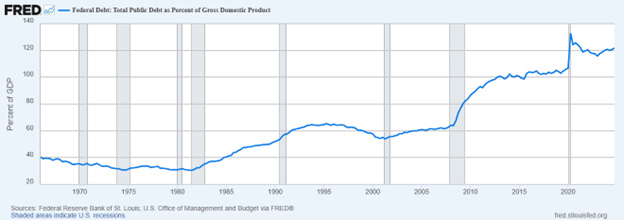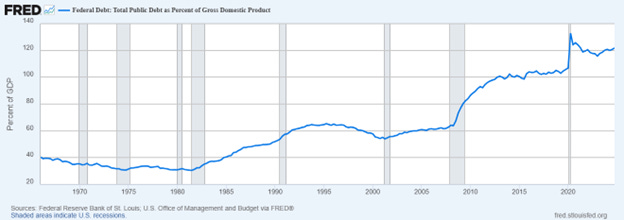There Is No Possible Bailout for the Federal Government
Forward this issue to your friends and urge them to subscribe.
Read all Life, Liberty, Property articles here, and full issues here and here.
IN THIS ISSUE:
- There Is No Possible Bailout for the Federal Government
- Video of the Week: The Big Beautiful Bill – In The Tank #497
- Trump’s Executive Orders Overturn the Progressive Dream
- Cartoon
- Bonus Video of the Week: “Poland, Rise Up!” — James Taylor Fires Up CPAC Poland
There Is No Possible Bailout for the Federal Government

With federal government debt projected to rise from the current $36.9 trillion to $54.4 trillion in 2034, the upward pressure on interest rates is sure to collapse the economy, greatly reduce federal tax revenues, and bring on defaults on government debt, Social Security, and Medicare, plus an inability to fund other entitlements, defense, and everything else the government does, sometime in the intervening years.
A household or business facing such a dire prospect would immediately take measures to avert it, including spending less, earning more if possible, and selling off assets, to pay down the debt; the alternative being bankruptcy (and the loss of those very assets). The U.S. government, by contrast, has always been able to rely on the American people and the great engine of growth that is the free-enterprise system to create a big enough pie from which to take its slice.
The government long ago became extremely comfortable with the fact that the American people have always been able to bail them out. Bailouts, however, notoriously lead to further bailouts and then to bankruptcies. It is a simple moral hazard: the unmatched prosperity-generating ability of America’s free-enterprise system tempts members of the government to think that they can dream as big as they want in their quest to buy votes. That was exactly what we experienced in 2021 through 2024.
As a result, we are rapidly reaching the limits of even the great American economy to fund government greed and overreach. The public has been hit from both ends: the government encourages consumption by overspending and suppresses production by overtaxing and overregulating. Here is what that looks like (skip past these charts if you have just eaten):


If the federal government were to come to its senses, it would start by cutting spending (by at least $2 trillion per year) and increasing revenues (by lowering tax rates and reducing regulation). We’ve seen how willing Congress has been to do that. Failing that, selling assets remains the other major option.
Unfortunately, that would not raise much money. “The federal government owns roughly 640 million acres, about 28% of the 2.27 billion acres of land in the United States,” the Congressional Research Service reported in 2020. Land and transportation policy analyst Randal O’Toole estimated at that time that selling all (politically) possible federal lands and the oil, natural gas, and coal on them would bring in at most $3.7 trillion. That would cover at most 14 percent of the 2020 federal debt, and we’re on track to add another $30 trillion to that in the next decade, more than doubling the debt.
In addition to land and the resources on it, the Federal Reserve estimates the national government’s other assets are worth $9.29 trillion. Of course, many of those assets are probably not in a sellable condition or things that anybody would want at the estimated price.
The $13 trillion that we would hope to raise by selling all those properties would not even pay for all the debt scheduled to be added between now and 2034, falling $4.5 trillion short. In addition, selling all that property would be a one-time deal, so the $13 trillion debt reduction would not be repeatable later if (when) the government goes on its merry way imagining that the American people are an unlimited source of tax money.
Perhaps in recognition that the government’s assets won’t get us very far, The Committee to Unleash Prosperity (CTUP) suggests a smaller land sale and additional measures to pay for more cuts to tax rates, totaling $6.55 trillion:

CTUP’s plan seems to recognize that major spending cuts are not a possibility and that the federal debt has already become so gargantuan that only rapid economic growth can possibly put off a crisis, by reducing the annual federal deficit below projections over the next decade. That is probably true. Instead of paying down the debt, CTUP proposes to stop adding to it, which would indeed be an improvement though not a solution.
Unfortunately, even that is exceedingly unlikely. The opposition party and the nation’s press and other institutions would immediately condemn any plan to implement CTUP’s suggested changes as a sell-off of the American people’s precious assets to pay for a massive tax cut for the rich.
I do not see any politically plausible scenario in which the U.S. government averts a fiscal crisis and default on the debt, with ensuing social chaos, in the coming years. Looking at all the numbers, the only real solution is obvious: pray for a miracle.
Source: Committee to Unleash Prosperity

Video of the Week

Join The Heartland Institute’s Linnea Lueken, S. T. Karnick, and Jim Lakely as they dive into Episode 497 of the In The Tank Podcast. This episode explores timely and provocative topics, including the Democrats’ ongoing quest to find their own version of podcast superstar Joe Rogan—can they cultivate a voice that resonates widely in the digital age?
The team also discusses President Joe Biden’s reliance on the autopen presidency. With Biden increasingly using automation and pre-scripted methods to fulfill presidential duties, what does this mean for transparency, authenticity, and public perception of leadership?
Finally, they break down former President Donald Trump’s “Big Beautiful Bill.” The hosts analyze its economic promises, potential impact on climate and energy policies, and how it stacks up against the Biden administration’s previous legislation. Tune in for insightful discussion, sharp analysis, and engaging debate on today’s critical issues.

Trump’s Executive Orders Overturn the Progressive Dream

U.S. presidents’ predilection for issuing executive orders is under intense scrutiny these days—because, of course, the current president is a Republican doing Republican things in a way Republicans do not ordinarily do things: aggressively, rapidly, and unapologetically. Trump has broken the deal the GOP made with the Democrats decades ago, that of being the loser party that shrugs its shoulders as the opposition builds a disastrously dysfunctional simulacrum of a totalitarian state that lacks even the minimal competence of the Soviet politburo.
It is fair to note that Trump has signed an extraordinary number of executive orders in his first four months in office: 157 thus far. Trump, however, is simply doing what all the presidents in this century have done. “In his first term, Trump signed 220, a seemingly high number, but no exception to recent trends (Joe Biden signed 162; Barack Obama and George W. Bush signed 276 and 291, respectively),” write Tyler Turman and Nikolai G. Wenzel at Law & Liberty.
In addition to the increasing number of executive orders, their scale and scope have expanded, Turman and Wenzel note:
Trump’s executive orders are the culmination of a long process of the expansion of executive authority. This trend has grown steadily over the last two centuries, leading to Trump’s famous remark that Article II of the US Constitution gives him the power to “do whatever I want as president.” While Trump is blunter than his predecessors, the presidential instinct is indeed bipartisan. We need only recall Obama’s explanation ten years ago: “We are not just going to be waiting for legislation in order to make sure that we’re providing Americans the kind of help that they need. I’ve got a pen, and I’ve got a phone. And I can use that pen to sign executive orders and take executive actions and administrative actions that move the ball forward.”
Executive orders are constitutionally allowed, the authors note:
As a matter of general principle, the president is free to manage the executive branch. Accordingly, the president has broad leeway in executive orders, which are intended only to direct the operations of the executive branch and ensure that existing legislation is faithfully executed; they must be based on existing legislation or constitutional authority (whether textual or delegated to the executive by Congress). Executive orders can be challenged in court, and they can be revoked by subsequent executive order. They can also be overridden by Congress. However, the overriding legislation is subject to presidential veto (and that veto, in turn, is subject to overturn by a congressional supermajority, in the delicate balance of separation of powers).
The problem that has arisen over the past two centuries and intensified in recent years is presidents’ use of their authority to “undermine or sidestep Congress,” the authors write. Congress has been at least as much at fault as the presidents have been, especially during the Progressive era that began at the end of the nineteenth century and has yet to recede, Turman and Wenzel observe:
To be sure, in the constant jockeying for power against the other branches, presidents have interpreted their constitutional authority generously. But the process of expansion was catalyzed by Congress’s willful delegation of authority to the presidency. Generally, Congress started giving quasi-legislative authority to the executive through the establishment of independent administrative agencies, starting with the Interstate Commerce Commission in 1887. Further examples abound. Congress has enacted legislation that broadens presidential authority, such as giving the president significant discretion in tariff policy (under national security powers or vague definitions of “unfair” trade practices), despite express definition of congressional authority under the commerce clause. Likewise, Congress has the express power to declare war (under Article I, Section 8), but has delegated powers to the president under, for example, the War Powers Resolution of 1973 or the Iraq War Resolution of 2002.
In his second term as president, Trump is using all those powers and authorizations to press his agenda. Courts have intervened intensively, as they have not done with any previous president. Those decisions, however, have failed to get to the heart of the matter, the authors write:
While the courts are indeed likely to strike down many of Trump’s most problematic actions, properly reinforcing the separation of powers and restoring the presidency to its proper scope would be achieved through a recommitment to the nondelegation doctrine and the Tenth Amendment. The nondelegation doctrine holds that Congress cannot divest its supreme legislative power and constrains the scope of the presidency to executing the law rather than creating it.
Although the nondelegation doctrine has not been invoked to strike down a statute since 1935, the principle is unambiguously congruent with the Framers’ understanding of the Constitution and flows directly from the constitutional doctrine of enumerated powers.
The fundamental deviation from constitutional government which the proliferation of executive orders exposes is the dystopian Progressive dream of ever-greater centralization of power in the central government, the explicit subject of the Tenth Amendment. As Turman and Wenzel write,
But the problem is more fundamental, and deeper: the real culprit is the vast expansion of federal powers and action.
The Constitution carefully enumerates the powers delegated to the federal government. In case of doubt, we are reminded by the Tenth Amendment that “the powers not delegated to the United States by the Constitution, nor prohibited by it to the States, are reserved to the States respectively, or to the people.” If the federal government had stayed within its constitutional lane, executive orders would be a minor issue. However, the federal government now controls about 25 percent of GDP, with an extra 10 percent spent each year on compliance with federal regulations. What is more, about 75 percent of federal activity is not authorized by the Constitution, which means, of course, that it is prohibited, under the constitutional doctrine of delegated and enumerated powers. But such an important presence in the economy means that the president will have greater discretion to implement laws, and we will see a partisan ping-pong of changing executive orders, rather than deliberation by the legislature.
Congress, the courts, and presidents have combined to create this system. The notion that the Executive Branch is overreaching is not quite accurate. Congressional delegation of powers to the executive occurred precisely because Congress wanted to increase its control, which requires a huge amount of administration and an enormous web of regulations and enforcement mechanisms. That was not something the Congress could accomplish on its own, nor that it would want to be bothered with, in addition to being impermanent because a new majority could change everything after the next election.
Instead, Congress stuffed the Executive Branch with a permanent bureaucracy staffed by civil servants it would be essentially impossible for later presidents to fire. Congress created this system and has continued to maintain it, to increase its own power while hoping to evade responsibility for the negative effects on individuals. Presidents were generally complicit and cooperative in this scheme, not challenging the basic structure to any great degree—until Trump’s second term. The same has been true of the courts, especially the Supreme Court.
All three branches of government will have to change their ways radically if they want to end the accumulation of gargantuan power in the Executive Branch. As Turman and Wenzel write,
Congress will need to find the fortitude to stand up for its prerogatives. As a first step, it could pass legislation to block presidential overreach. It could also refrain from delegating legislative authority to the president for political expediency and roll back past delegations. Reviving the nondelegation doctrine would require Congress to limit the discretion granted to agencies, reevaluate existing regulatory frameworks, and restore constitutional equilibrium by ensuring that the expansion of executive power is kept in check.
I doubt that this will happen. Legislative power belongs to Congress, and the legislature has deployed lawmaking by executive order for its own ends, in particular the expansion of federal power. The idea that all three branches would agree to restore obedience to the Tenth Amendment, restore power to the states and to the people, and end the administrative state is almost certainly fanciful. My expectation is that Congress and the Supreme Court will do no more than tinker at the edges while continuing down their current course until unconstitutional and clearly demented federal spending, debt, and regulation destroy the U.S. economy and the federal government collapses as a result.
Trump is trying to delay that dreadful day. It seems likely, however, that the catastrophe is already baked into the burgeoning national debt and coming inability of the federal government to fulfill the multitude of promises it has fecklessly taken on, which have become obligations under the description of entitlements. Naturally, all the rest of the government and the nation’s institutions are intent on stopping Trump from averting this nightmare, other than a few hardy souls such as The Heartland Institute and other pro-freedom think tanks, plus a small number of ineffectual idealists in government, such as Rep. Thomas Massie and Sen. Rand Paul. In the war between fools and the U.S. Constitution, the fools always end up with the win.
NEW Heartland Policy Study
‘The CSDDD is the greatest threat to America’s sovereignty since the fall of the Soviet Union.’


via Townhall
Bonus Video of the Week

Heartland Institute President James Taylor electrifies CPAC Poland with a rallying cry for faith, family, and freedom. Speaking in Jasionka on May 27, 2025, Taylor salutes Poland’s centuries-long defiance of tyranny and urges conservatives across Europe to “stand tall for freedom” in the face of mounting EU pressure to adopt Net-Zero policies. He reminds the crowd that for most of recorded history the climate has been warmer than today, yet humanity thrived, and he warns that “totalitarian socialists” in Brussels threaten both prosperity and national sovereignty.
Taylor lays out a blueprint for economic revival built on abundant coal, natural gas, and nuclear power, echoing the energy boom unleashed in the United States under President Trump. Finally, he calls on every Pole—and every European—to raise their flag high and join a growing international movement for liberty and independent nation-states.

Contact Us
The Heartland Institute
3939 North Wilke Road
Arlington Heights, IL 60004
p: 312/377-4000
f: 312/277-4122
e: [email protected]
Website: Heartland.org








